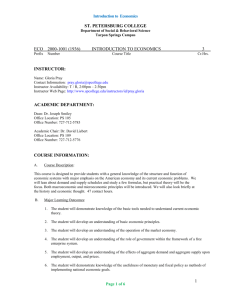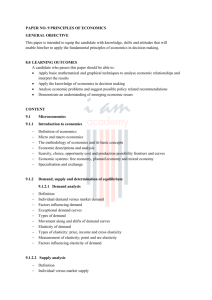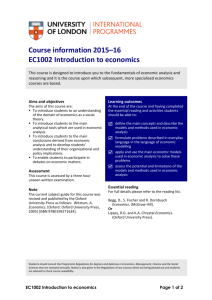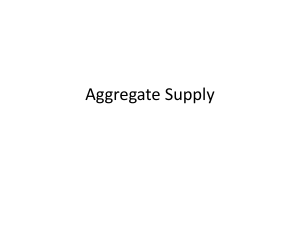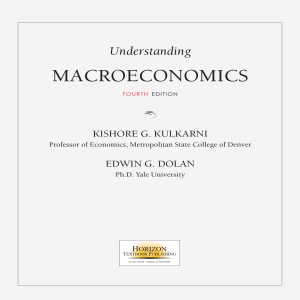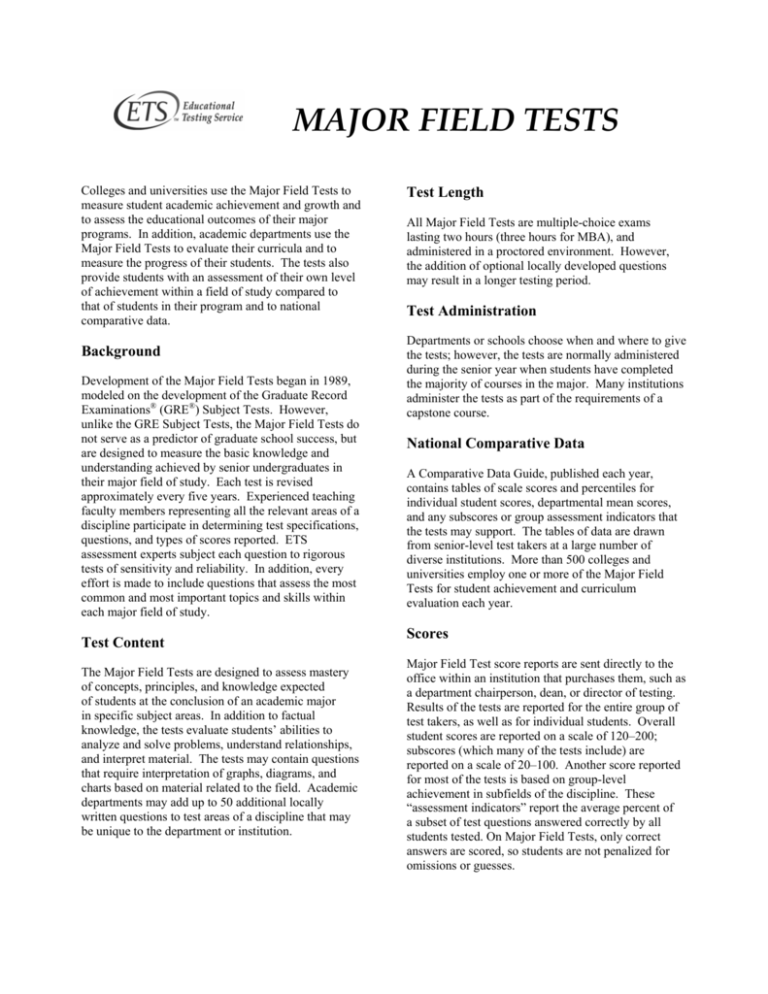
MAJOR FIELD TESTS
Colleges and universities use the Major Field Tests to
measure student academic achievement and growth and
to assess the educational outcomes of their major
programs. In addition, academic departments use the
Major Field Tests to evaluate their curricula and to
measure the progress of their students. The tests also
provide students with an assessment of their own level
of achievement within a field of study compared to
that of students in their program and to national
comparative data.
Background
Development of the Major Field Tests began in 1989,
modeled on the development of the Graduate Record
Examinations® (GRE®) Subject Tests. However,
unlike the GRE Subject Tests, the Major Field Tests do
not serve as a predictor of graduate school success, but
are designed to measure the basic knowledge and
understanding achieved by senior undergraduates in
their major field of study. Each test is revised
approximately every five years. Experienced teaching
faculty members representing all the relevant areas of a
discipline participate in determining test specifications,
questions, and types of scores reported. ETS
assessment experts subject each question to rigorous
tests of sensitivity and reliability. In addition, every
effort is made to include questions that assess the most
common and most important topics and skills within
each major field of study.
Test Content
The Major Field Tests are designed to assess mastery
of concepts, principles, and knowledge expected
of students at the conclusion of an academic major
in specific subject areas. In addition to factual
knowledge, the tests evaluate students’ abilities to
analyze and solve problems, understand relationships,
and interpret material. The tests may contain questions
that require interpretation of graphs, diagrams, and
charts based on material related to the field. Academic
departments may add up to 50 additional locally
written questions to test areas of a discipline that may
be unique to the department or institution.
Test Length
All Major Field Tests are multiple-choice exams
lasting two hours (three hours for MBA), and
administered in a proctored environment. However,
the addition of optional locally developed questions
may result in a longer testing period.
Test Administration
Departments or schools choose when and where to give
the tests; however, the tests are normally administered
during the senior year when students have completed
the majority of courses in the major. Many institutions
administer the tests as part of the requirements of a
capstone course.
National Comparative Data
A Comparative Data Guide, published each year,
contains tables of scale scores and percentiles for
individual student scores, departmental mean scores,
and any subscores or group assessment indicators that
the tests may support. The tables of data are drawn
from senior-level test takers at a large number of
diverse institutions. More than 500 colleges and
universities employ one or more of the Major Field
Tests for student achievement and curriculum
evaluation each year.
Scores
Major Field Test score reports are sent directly to the
office within an institution that purchases them, such as
a department chairperson, dean, or director of testing.
Results of the tests are reported for the entire group of
test takers, as well as for individual students. Overall
student scores are reported on a scale of 120–200;
subscores (which many of the tests include) are
reported on a scale of 20–100. Another score reported
for most of the tests is based on group-level
achievement in subfields of the discipline. These
“assessment indicators” report the average percent of
a subset of test questions answered correctly by all
students tested. On Major Field Tests, only correct
answers are scored, so students are not penalized for
omissions or guesses.
ECONOMICS (3YMF)
(Current form introduced in January 2002)
The Major Field Test in Economics contains 90
multiple-choice questions, some of which are grouped
in sets and based on such materials as diagrams,
expository paragraphs, sets of equations, and tables of
data.
3.
4.
The content categories and approximate distribution of
questions among them are outlined below.
I.
E. Market Structures, short- and Long-run
Equilibriums
1. Perfect competition
2. Monopoly
3. Oligopoly, cartels and game theory
4. Monopolistic competition
Introductory Material (4 percent)
A. Scarcity
B. Opportunity Costs and Production
Possibilities
C. Positive vs. Normative Economics
II.
F. Factor markets
1. Derived demand
2. Labor markets
a. competitive markets
b. monopsony
c. labor unions
3. Capital markets
a. present discounted value
b. market equilibrium
Microeconomics (37 percent)
A. Supply and Demand
1. Equilibrium and basic manipulations
2. Consumer/producer surplus
3. Excise taxes – market effects and
incidence
B. Elasticity
1. Demand elasticity and applications
a. price elasticity
b. income elasticity
c. cross-price elasticity
d. Price elasticity and total revenue
2. Supply elasticity
C. Consumer Choice
1. Utility functions and indifference
curves
2. Budget constraints
3. Utility maximization
4. Comparative statics
a. income effects
b. price effects
c. derivation of individual demand
curves/labor supply curves
D. Production Functions and Costs
1. Production functions
a. short-run
b. long-run
2. Short-run cost functions – TC, VC,
FC (sunk costs), AVC, ATC, AFC,
MC and relationships between them
Isoquants and isocosts
a. static equilibrium, effects of
changes in factor prices
b. factor substitution
Long-run costs
a. returns to scale
b. firm and industry equilibrium
G. Government intervention in markets
1. Price ceilings and price floors
2. Impact of taxes
3. Regulations and anti-trust
III.
Macroeconomics (35 percent)
A. Circular flow
1. Basic concepts
2. Leakages and injections (S,T,M)
versus (I,G,X)
3. International capital flows
B. Economic measurement
1. GDP
a. accounting methods
(expenditure vs. income)
b. domestic components
c. international component
2. Price indices and inflation
3. Unemployment
C. Aggregate supply-aggregate demand
models of macro equilibrium
1.
2.
3.
4.
Aggregate demand
a. definition and components of
aggregate demand
(1) consumption spending,
including consumption
functions
(2) investment spending,
including marginal
efficiency of investment
(3) government sector
(4) foreign sector, including
product and capital
expenditures
b. derivation of aggregate demand
c. shifting aggregate demand
Aggregate supply
a. definition of aggregate supply
b. Keynesian (short-run) aggregate
supply
Macro-economic equilibrium –
Keynesian vs. (neo-) classical
Economic growth
D. Money and financial markets
1. Definition and role of money
2. Supply of money
a. definitions of money supply and
monetary base
b. commercial banks/financial
institutions
c. role of the Federal Reserve
System
3. Demand for money
4. Interest rates
5. Relationship between money supply
and interest rates
6. Monetary theory
E. Macroeconomic policy analysis
1. Unemployment
2. Inflation
3. Fiscal policy
4. Monetary policy
5. IS/LM analysis
6. Comparison of policy perspectives
(Keynesian, post-Keynesian, new
Keynesian, monetarist, new classical,
expectations, etc.)
7. Federal deficit and federal debt
8. Issues in an open economy
IV.
Statistics (9 percent)
A.
B.
C.
D.
V.
Concepts of probability
Descriptive statistics
Hypothesis testing
Simple regression
Other areas (15 percent)
A. International economics
1. Absolute and comparative advantage
2. Trade restrictions – tariff and nontariff
3. Balance of trade/balance of payments
4. Exchange rates
a. flexible exchange rates
b. fixed exchange rates
c. other exchange rates system
5. Regional economic integration
B. Public economics
1. Externalities
2. Public goods
3. Market failure/government failure
4. Public choice
5. Property rights
6. Transactions costs
C. History of economic thought
D. Economic history
VI.
Data analysis (15-20 percent across all content
areas).
Scores for the Economics Major Field Test are
reported as follows:
Total Score
Reported for each student and summarized for the
group.
Subscores
Reported for each student and summarized for the
group.
•
•
Microeconomics (33)
Macroeconomics (31)
Assessment Indicators
Reported for the group* only.
• Data Analysis (15)
____________________________
Numbers in parentheses are approximate number of questions in
each category.
*A minimum of five students is required for assessment indicators
to be reported.
Copyright © 2002 by Educational Testing Service. All rights reserved. EDUCATIONAL TESTING
SERVICE, ETS, the ETS logo, GRADUATE RECORD EXAMINATIONS, and GRE are registered
trademarks of Educational Testing Service. HIGHER EDUCATION ASSESSMENT is a trademark of
Educational Testing Service.
Permission to reproduce this document is hereby granted to institutions (colleges and universities)
administering the Major Field Tests for internal use only. No commercial or further distribution is
permitted. Other persons or agencies wishing to obtain permission to reproduce this material may write to
the Permissions Administrator at Educational Testing Service, Princeton, New Jersey 08541.





